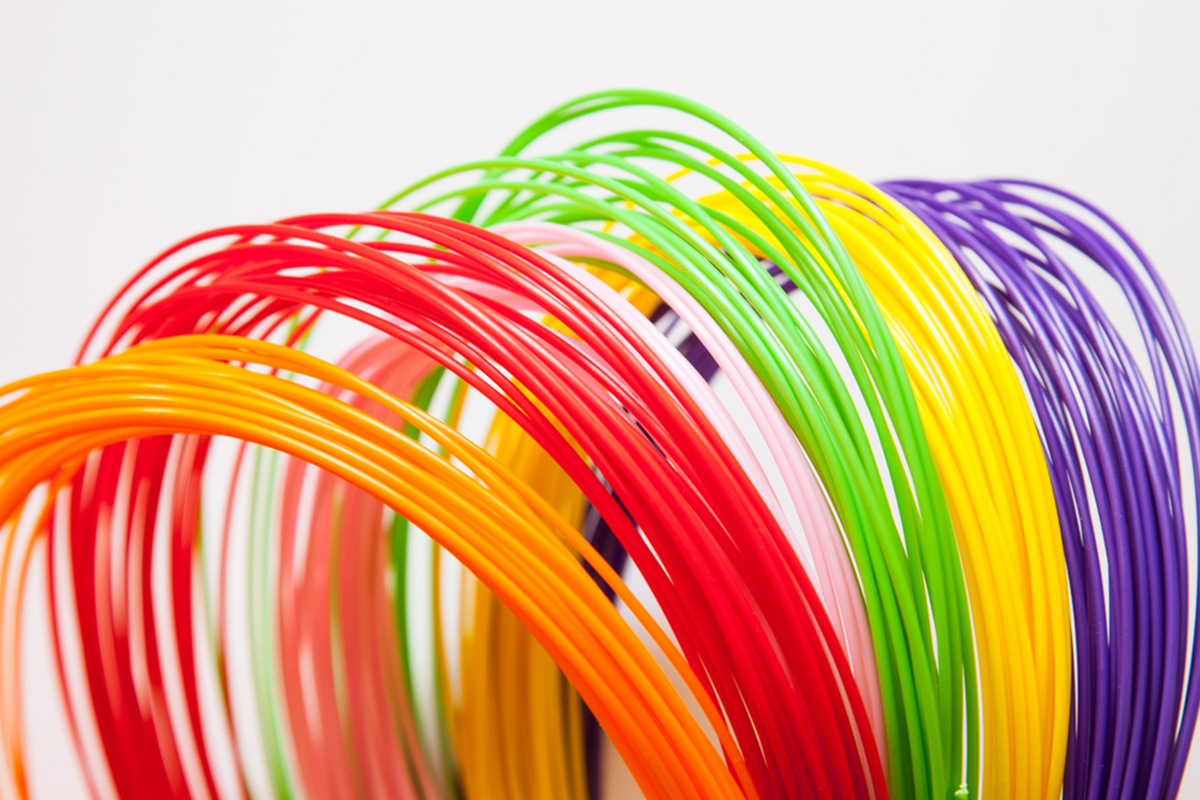
3D Printer Filaments ABS and PLA Guideline
Acrylonitrile butadiene styrene (ABS) is one of the most common filaments used in 3D printing. If you paid attention in chemistry class, you’ll probably sense that the last two words sound chemical. The last word indeed sounds like polystyrene which is used in packaging – and chances are that you’ve held a flame against it as a child and discovered that it melts and smells bad. The melting part is what makes ABS a thermoplastic polymer suitable for FFF 3D printing.
ABS is often used in industrial 3D printing and has been a very popular plastic in the development of prosumer 3D printing. It melts consistently at around 225°C, which can easily be achieved with small and home-safe electronics. It is relatively strong, slightly flexible and has a high glass transition temperature of around 100°C. That’s the temperature above which a plastic goes from its solid state to a pliable state where it can lose its shape. These characteristics mean ABS is very suitable for printing functional parts, like spare parts for machines or objects that are exposed to high temperatures like sunlight or hot water. ABS is dissolvable in acetone. This is a widely available and relatively safe chemical that most people recognise as the ingredient in nail polish remover, however, not all nail polish removers contain 100% acetone. Acetone is used to smooth the surface of a 3D printed object. Sanding an ABS print and then wiping it with acetone will dissolve the outer layer, essentially smoothing it by reducing the visibility of layers in the print. To fully take advantage of this you smooth prints with acetone vapour. I would like to say in advance that this technique deserves the “don’t try this at home” warning. While acetone vapour can remove small intended details, it will give ABS prints – that otherwise have a matte finish – a high, glossy look.
The downsides of ABS are the smell it produces while being heated, which is neither nice or healthy to live or work around and the fact that it expands and shrinks in the process of being heated and cooled down again. The shrinkage, in particular, is a problem for 3D printing, because it causes 3D prints to curl up while cooling too quickly, which is called warping. To counteract this, ABS has to be printed on a heated build plate and preferably in an enclosed, heated build chamber – so it stays warm during printing and can cool down slowly when printing is done. A heated build plate and chamber usually increases the price of a 3D printer and it uses considerably more electricity. So while ABS also comes in green, it’s far from it in terms of health and climate awareness. The third downside of ABS is that the bonding between layers isn’t always perfect.
Polylactic acid (PLA) is a completely different kind of thermoplastic. It’s made from cornstarch or sugarcane and is biodegradable, so it’s greener than ABS. It can melt at a lower temperature between 190°C and 210°C and doesn’t smell bad when it does. In fact, many people like the smell of hot PLA. I’ve even read that people refer to it as the smell of waffles, but they probably have never been to Belgium.
Because PLA flows a little better than ABS, you can print more detailed objects with it at higher speeds. It’s especially good at producing sharp corners. It also is a lot less prone to warping, so you won’t necessarily need a heated print bed to print PLA. However, if you want to print objects with a large flat bottom surface without the edges warping a bit, a little bit of heat (around 60°C) from the bed can counteract this. PLA prints have a relatively glossy surface compared to ABS, but the amount of gloss depends on the vendor, colour and print temperature. Advanced users could vary the glossiness of different parts of a single print by varying the temperature during the printing process.
Unlike ABS, PLA isn’t dissolvable in acetone. It can be dissolved in sodium hydroxide. That’s what’s in drain cleaner and if you’ve ever used that you know it’s dangerous stuff, to say the least. Some people use PLA as a dissolvable support for ABS prints on dual extrusion printers, but I would advise to only use sodium hydroxide when you have a nozzle that’s clogged by PLA. Even then, you should very carefully choose a container for this, since sodium hydroxide can also dissolve some types of glass. If that scares you, just buy a new nozzle.
The optional heated bed has to be set around 60°C because this is the glass transition temperature of PLA. This means that it gets pliable above that, which means it’s not very suitable for objects that get exposed to high temperatures. It’s also fairly brittle, so you wouldn’t want to use it for functional parts that have to last a while. PLA is simply easier to print with than ABS, so the conclusion is that PLA is currently the best “standard” material for home and office 3D printing of decorative objects.
How to choose the right filament
After reading the information above it becomes clear that there’s a list of characteristics to consider when choosing filament and that ABS and PLA are quite opposite when it comes to printing. There are a few more things to keep in mind when choosing filament, so here’s an overview.
Ensure you know the melting temperature of the plastic you’re using, so you know if your extruder can reach this temperature.
Know the glass melting temperature of the plastic you use, so you know if it’s suitable for the ambient temperature of your purpose.
Understand the printing environment, so you can determine if the smell and chemical fumes are a problem.
Understand the requirements for a heated bed to prevent warping.
Understand the stiffness or flexibility of the plastic, so you know what forces it can withstand.
Know the advised print speed of the filament you’re using as some have to be printed extremely slow for good results.
Know the variety of ways you can improve the aesthetics of your printed objects. Some materials can be sanded, polished, vapour-smoothed, painted or finished otherwise to get interesting results, some cannot.
Know the availability of the colour you require. ABS and PLA are available in almost every colour, but other plastics have a more limited range. Some materials even offer special effects, like glitters, glow-in-the-dark or colour changes by heat or light.
Understand the compatibility between a material and your 3D printer and extruder type. Read both your printer’s manual and warranty conditions before experimenting with materials. Some materials can seriously damage certain extruders and because of this printer manufacturers won’t allow the use of different filament brands other than those they’re selling. What’s also important is to check which filament diameter your printer supports. Most printers use 1.75mm filament but some (like the Ultimakers) use 2.85mm filament, which is sometimes referred to as “3mm”.
Understand the size of the spool. Every printer has its own way of suspending the filament spool while printing and can usually accommodate a wide range of spool sizes. However, some vendors design their printers so they can only hold their own filament. MakerBot has done this with it’s latest 5th generation line of printers which can only hold their own very wide and flat spools. Some printers even use dedicated cartridges instead of spools, so you can only use their brand, comparable to 2D printers. There are also FFF 3D printers in development that don’t use spooled filament altogether, but instead, use the pelletized filament, but at the moment most use spools.
Filament prices and the differences between premium and non-premium
You can imagine that special kinds of filament are more expensive compared to regular ones. The filament with special colours or effects come at a higher price. When exploring what and where to buy your filament, you’ll quickly discover that prices of standard coloured filament – let’s say red PLA – can range between €10 and €50 per kg. Some part of that is pure marketing: they’re more expensive because you also pay for the brand like you do with clothing. But another part is quality. A very cheap filament is sometimes made from less quality sourced material and is usually less well checked for consistency.
Premium filament usually (not always) costs between $25 and $50 per kilogram, but comes from better suppliers that offer better quality checking in the production process. The most important factor in this is the filament diameter. If a 3D printer is designed for 1.75mm filament, it needs to be very close to that measurement. If it is too wide, filament could jam the extruder. If it is too narrow, filament could lead to the extruder gears losing grip and extruding inconstantly, resulting in lower-quality prints.
In the current market it’s hard to say for sure which filaments are “premium”, but those that usually have their own brand name – or are certified by 3D printer manufacturers and are made by a traceable manufacturer that supplies all kind of characteristics of the plastic on their website.
I won’t go into the pricing of the filaments I’ll cover below, because they may vary over time and can depend on your currency and location. Just make sure that when you check the weight when you compare prices. Spools usually contain either 0.75kg or 1kg of the filament, but MakerBot’s large spools, for instance, contain 0.9kg. You might also find very big spools of 2kg plus, but keep in mind that they could be either too large for your spool holder, or too heavy for your extruder motor to unroll. Very big spools can best be put on a separate spool holder with some kind of bearing system. You can easily 3D print one yourself by downloading one of the many custom spool holder models on Thingiverse.
This information was provided by Nick Lievendag. He has an amazing blog with lots of informative information. If you’re looking to purchase filament in New Zealand check out our website here.

